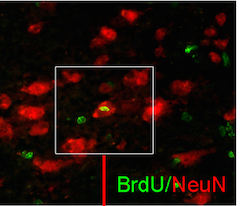I’d like to highlight a paper in PLOS One from anesthesiologists Shan Ping Yu and Ling Wei’s group that was published earlier this year. [Sorry for missing it then!] They are investigating potential therapies for stroke, long a frustrating area of clinical research. The “clot-busting†drug tPA remains the only FDA-approved therapy, despite decades of work on potential neuroprotective agents.
Yu’s team takes a different tactic. They seek to bolster the brain’s recovery powers after stroke by mobilizing endogenous progenitor cells. I will call this approach “stem cells lite.â€

PTH appears to encourage new neurons in recovery in a mouse model of ischemic stroke. Green = recent cell division, red = neuronal marker
It is similar to that taken by cardiologist Arshed Quyyumi and colleagues with peripheral artery disease: use a growth factor (GM-CSF), which is usually employed for another purpose, to get the body’s own regenerative agents to emerge from the bone marrow.
In this case, Yu’s team was using parathyroid hormone (PTH), which is an FDA-approved treatment for osteoporosis. They administered it, beginning one hour after loss of blood flow, in a mouse model of ischemic stroke. They found that daily treatment with PTH spurs production of endogenous regenerative factors in the stroke-affected area of the brain. They observed both increased new neuron formation and sensorimotor functional recovery. However, PTH does not pass through the blood-brain barrier and does not change the size of the stroke-affected area, the researchers found.
The conclusion of the paper hints at their next steps:
As this is the first report on this PTH therapy for ischemic stroke for the demonstration of the efficacy and feasibility, PTH treatment was initiated at 1 hr after stroke followed by repeated administrations for 6 days. We expect that even more delayed treatment of PTH, e.g. several hrs after stroke, can be beneficial in promoting chronic angiogenesis and other tissue repair processes. This possibility, however, remains to be further evaluated in a more translational investigation.





